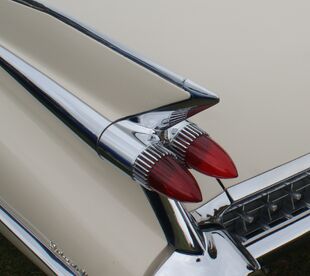
Cadillac Tailfin
The Tailfin era of automobile styling encompassed the 1950s and 1960s, peaking between 1957 and 1960. It was a style that spread worldwide, as car designers picked up styling trends from the US automobile industry where it was the golden epoch of American autodesign.
General Motors design chief Harley Earl is generally credited for the automobile tailfin, introducing small fins on the 1948 Cadillac. Harley credited the look of World War II fighter aircraft for his inspiration, particularly the twin-tailed P-38 Lightning. As jet-powered aircraft, rockets, and space flight entered into public recognition, the automotive tailfin assemblies (including tail lights) were designed to resemble more and more the tailfin and engine sections of contemporary jet fighters and space rockets.
Plymouth claimed that the Tailfins were not Fins, but "stabilizers" to place the "center of pressure" as far to the rear as possible and thus "reduce by 20% the needs for steering correction in a cross wind".
Some sub-models of the 1937 Cadillac Fleetwood, which predates the P-38, also contained hints of tailfins via projecting tail-light "paddles", although it is unclear if this influenced later fin designs. The 1941 Cadillac Series 63 4-Door Sedan also had a form of jutting tail-lights, although milder than the 1937 Fleetwood. Even though the 1948 model was the first conscious effort at fins, the earlier partial occurrences may have made the concept more acceptable to consumers and designers. (World War II produced a gap of Cadillac model production between the early 40s and late 40s as factories turned to military goods production, interrupting the development of the fin concept.) The Cadillac 1948 fin styling proved popular and its use spread to other models in the General Motors family of brands. Soon it was adopted by other manufacturers; Chrysler's Virgil Exner in particular took the tailfin idea on board. As confidence grew in the styling trend, the fins grew larger and bolder.
The most extreme tailfins appeared in the late 1950s. The fins on the 1959 Cadillac Eldorado were the largest and most outrageous ever fitted on a production car. Those fins were too much for many customers, however, and the tailfins shrank after that point. Within a couple of years, tailfins had become much less prominent, and by the mid 1960s, they were gone on many models. Vestigial tailfins remained on American cars into the 1980s, with the sides of the quarter panels often being raised above the trunk lid and the corner sharp-edged, or at least raised. Cadillac was one of the last makers to phase raised edges out, with vertically-arranged tail-light assemblies as well, on all of their products (except the Allanté) all the way to the early 1990s.
Mercedes used something similar to tailfins (nicknamed "Heckflosse" in German), but they claimed that these were not tailfins but "sight lines" (Peilstege) to make it easier to determine the corners of the vehicle. In 1997, Lancia introduced the Lancia Kappa Coupé with similar rear "sight line" augmentation.
In 2010, the Cadillac SRX styling incorporated the trademark vertical taillights sculpted into tiny tailfins projecting from the rear.
Tailfins have been criticized as a safety concern, even as a parked vehicle. In Kahn v. Chrysler (1963), a 7 year old child on a bicycle collided with a fin and sustained a head injury. A case of the same era, Hatch v. Ford (1958), is also prominent in the study of personal injury from parked vehicles. In both of these cases, children were injured by sharp protrusions on parked cars.
